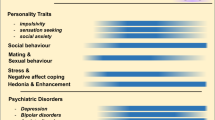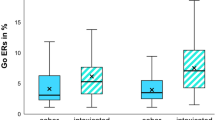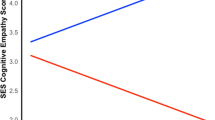Abstract
Adolescence is a vulnerable period for the development of substance use and related problems. Understanding how exposure to drugs influences the adolescent brain could reveal mechanisms underlying risk for addiction later in life. In the current study, 87 adolescents (16–20-year olds; the local legal drinking age was16, allowing the inclusion of younger subjects than usually possible) underwent EEG measurements during a Go/No-Go task with and without alcohol cues; after placebo and a low dose of alcohol (0.45 g/kg). Conflict monitoring and error detection processes were investigated with the N2 and the error-related negativity (ERN) ERP components. Participants were followed-up after 6 months to assess changes in alcohol use. The NoGo-N2 was larger for alcohol cues and acute alcohol decreased the amplitude of the NoGo-N2 for alcohol cues. ERN amplitude was blunted for alcohol cues. Acute alcohol decreased the amplitude of the ERN, specifically for control cues. Furthermore, the differences in ERN for alcohol cues between the placebo and alcohol conditions predicted alcohol use 6 months later: subjects who showed stronger blunting of the ERN after acute alcohol were more likely to return to more moderate drinking patterns. These results suggest that cues signalling reward opportunities might activate a go-response mode and larger N2 (detection of increased conflict) for these cues might be necessary for inhibition. The ERN results suggest a deficiency in the monitoring system for alcohol cues. Finally, a lack of alcohol-induced deterioration of error monitoring for cues with high salience might be a vulnerability factor for alcohol abuse in adolescents.
Similar content being viewed by others
Log in or create a free account to read this content
Gain free access to this article, as well as selected content from this journal and more on nature.com
or
References
Adams S, Ataya AF, Attwood AS, Munafo MR (2013). Effects of alcohol on disinhibition towards alcohol-related cues. Drug Alcohol Depend 127: 137–142.
Bartholow BD, Henry EA, Lust SA (2007). Effects of alcohol sensitivity on P3 event-related potential reactivity to alcohol cues. Psychol Addict Behav 21: 555–563.
Bartholow BD, Henry EA, Lust SA, Saults JS, Wood PK (2012). Alcohol effects on performance monitoring and adjustment: affect modulation and impairment of evaluative cognitive control. J Abnorm Psychol 121: 173–186.
Bartholow BD, Lust SA, Tragesser SL (2010). Specificity of P3 event-related potential reactivity to alcohol cues in individuals low in alcohol sensitivity. Psychol Addict Behav 24: 220–228.
Bartholow BD, Pearson M, Sher KJ, Wieman LC, Fabiani M, Gratton G (2003). Effects of alcohol consumption and alcohol susceptibility on cognition: a psychophysiological examination. Biol Psychol 64: 167–190.
Bekker EM, Kenemans JL, Verbaten MN (2005). Source analysis of the N2 in a cued Go/NoGo task. Brain Res Cogn Brain Res 22: 221–231.
Casey BJ, Jones RM (2010). Neurobiology of the adolescent brain and behavior: implications for substance use disorders. J Am Acad Child Adolesc Psychiatry 49: 1189–1201.
Claus E, Feldstein Ewing SW, Filbey FM, Hutchison KE (2013). Behavioral control in alcohol use disorders: relationships with severity. J Stud Alcohol Drugs 74: 141–151.
Crone EA, Dahl RE (2012). Understanding adolescence as a period of social-affective engagement and goal flexibility. Nat Rev Neurosci 13: 636–650.
Deutsch R, Gawronski B, Strack F (2006). At the boundaries of automaticity: negation as reflective operation. J Pers Soc Psychol 91: 385–405.
Duka T, Townshend JM (2004). The priming effect of alcohol pre-load on attentional bias to alcohol-related stimuli. Psychopharmacology (Berl) 176: 353–361.
Easdon C, Izenberg A, Armilio ML, Yu H, Alain C (2005). Alcohol consumption impairs stimulus- and error-related processing during a Go/No-Go Task. Brain Res Cogn Brain Res 25: 873–883.
Fein G, Chang M (2008). Smaller feedback ERN amplitudes during the BART are associated with a greater family history density of alcohol problems in treatment-naïve alcoholics. Drug Alcohol Depend 92: 141–148.
Field M, Kierman A, Eastwood B, Child R (2008). Rapid approach responses to alcohol cues in heavy drinkers. J Behav Ther Exp Psy 39: 209–218.
Field M, Wiers RW, Christiansen P, Fillmore MT, Verster JC (2010). Acute alcohol effects on inhibitory control and implicit cognition: Implications for loss of control over drinking. Alcohol 34: 1346–1352.
Gladwin TE, Figner B (2014). "Hot" cognition and dual systems: Introduction, criticisms, and ways forward. In: Wilhelms E, Reyna VF (eds). Frontiers of Cognitive Psychology Series: Neuroeconomics, Judgment and Decision Making. Psychological Press: New York. pp 157–180.
Gladwin TE, Figner B, Crone EA, Wiers RW (2011). Addiction, adolescence, and the integration of control and motivation. Dev Cogn Neurosci 1: 364–376.
Graham JW, Flay BR, Johnson CA, Hansen WB, Grossman L, Sobel JL (1984). Reliability of self-report measures of drug use in prevention research: Evaluation of the Project SMART questionnaire via the test–retest reliability matrix. J Drug Edu 14: 175–193.
Gratton G, Coles MGH, Donchin E (1983). A new method for off-line removal of ocular artifact. Eletroencephalogr Clin Neurophysiol 55: 468–484.
Grose-Fifer J, Rodrigues A, Hoover S, Zottoli T (2013). Attentional capture by emotional faces in adolescence. Adv Cogn Psychol 9: 81–91.
Hernández OH, Vogel-Sprott M (2010). Alcohol slows the brain potential associated with cognitive reaction time to an omitted stimulus. J Stud Alcohol Drugs 71: 268–277.
Herrmann MJ, Weijers HG, Wiesbeck GA, Aranda D, Böning J, Fallgatter AJ (2000). Event-related potentials and cue-reactivity in alcoholism. Alcohol Clin Exp Res 24: 1724–1729.
Jentsch JD, Taylor JR (1999). Impulsivity resulting from frontostriatal dysfunction in drug abuse: implications for the control of behavior by reward-related stimuli. Psychopharmacology (Berl) 146: 373–390.
Johnsen BH, Laberg JC, Cox WM, Vaksdal A, Hugdahl K (1994). Alcoholic subjects ’ attentional bias in the processing of alcohol-related words. Psychol Addict Behav 8: 111–115.
Kreusch F, Vilenne A, Quertemont E (2013). Response inhibition towards alcohol-related cues using an alcohol go/no-go task in problem and non-problem drinkers. Addict Behav 38: 2520–2528.
Larson MJ, Perlstein WM, Stigge-Kaufman D, Kelly KG, Dotson VM (2006). Affective context-induced modulation of the error-related negativity. Neuroreport 17: 329–333.
Lavric A, Pizzagalli DA, Forstmeier S (2004). When ‘go’ and ‘nogo’ are equally frequent: ERP components and cortical tomography. Eur J Neurosci 20: 2483–2488.
Love A, Es DJAM, Willner P (1998). A comparison of two alcohol craving questionnaires. Addiction 93: 1091–1102.
Luijten M, Littel M, Franken IHA (2011). Deficits in inhibitory control in smokers during a Go/NoGo task: an investigation using event-related brain potentials. PLoS One 6: e18898.
Newlin DB, Thomson JB (1990). Alcohol challenge with sons of alcoholics: A critical review and analysis. Psychol Bull 108: 383–402.
Nieuwenhuis S, Yeung N, van den Wildenberg W, Ridderinkhof KR (2003). Electrophysiological correlates of anterior cingulate function in a go/nogo task: effects of response conflict and trial type frequency. Cogn Affect Behav Neurosci 3: 17–26.
Nigg JT, Glass JM, Wong MM, Poon E, Jester JM, Fitzgerald HE et al (2004). Neuropsychological executive functioning in children at elevated risk for alcoholism: findings in early adolescence. J Abnorm Psychol 113: 302–314.
Nigg JT, Wong MM, Martel MM, Jester JM, Puttler LI, Glass JM et al (2006). Poor response inhibition as a predictor of problem drinking and illicit drug use in adolescents at risk for alcoholism and other substance use disorders. J Am Acad Child Adolesc Psychiatry 45: 468–475.
Norman AL, Pulido C, Squeglia LM, Spadoni AD, Paulus MP, Tapert SF (2011). Neural activation during inhibition predicts initiation of substance use in adolescence. Drug Alcohol Depend 119: 216–223.
Noël X, Linden M, Van der, d’Acremont M, Bechara A, Dan B, Hanak C et al (2007). Alcohol cues increase cognitive impulsivity in individuals with alcoholism. Psychopharmacology (Berl) 192: 291–298.
Petit G, Kornreich C, Noël X, Verbanck P, Campanella S (2012). Alcohol-related context modulates performance of social drinkers in a visual Go/No-Go task: a preliminary assessment of event-related potentials. PLoS One 7: e37466.
Ridderinkhof KR, De Vlugt Y, Bramlage A, Spaan M, Snel J, Band GPH (2002). Alcohol consumption impairs detection of performance errors in mediofrontal cortex. Science 298: 2209–2211.
Rueger SY, McNamara PJ, King AC (2009). Expanding the utility of the Biphasic Alcohol Effects Scale (BAES) and initial psychometric support for the Brief-BAES (B-BAES). Alcohol Clin Exp Res 33: 916–924.
Saunders JB, Aasland OG, Babor TF, de la Fuente JR, Grant M (1993). Development of the Alcohol Use Disorders Identification Test (AUDIT): WHO collaborative project on early detection of persons with harmful alcohol consumption—II. Addiction 88: 791–804.
Schuckit MA, Smith TL, Kalmijn J, Tsuang J, Hesselbrock V, Bucholz K (2000). Response to alcohol in daughters of alcoholics: a pilot study and a comparison with sons of alcoholics. Alcohol Alcohol 35: 242–248.
Sharma D, Albery IP, Cook C (2001). Selective attentional bias to alcohol related stimuli in problem drinkers and non-problem drinkers. Addiction 96: 285–295.
Sobell LC, Sobell MB (1992). Timeline followback: A technique for assessing self-reported alcohol consumption. In: Allen J, Litten RZ (eds). Measuring alcohol consumption: Psychosocial and biological methods. Humana: Totowa NJ. pp 41–72.
Stacy AW, Ames SL, Knowlton BJ (2004). Neurologically plausible distinctions in cognition relevant to drug use etiology and prevention. Subst Use Misuse 39: 1571–1623.
Van Veen V, Carter C (2002). The anterior cingulate as a conflict monitor: fMRI and ERP studies. Psychol Behav 77: 477–482.
Watson D, Clark LA, Tellegen A (1988). Development and validation of brief measures of positive and negative affect: the PANAS scales. J Pers Soc Psychol 54: 1063–1070.
White HR, Labouvie EW (1989). Towards the assessment of adolescent drinking problems. J Stud Alcohol 50: 30–37.
Wiers RW, Bartholow BD, Wildenberg E, van den, Thush C, RCME Engels, Sher KJ et al (2007). Automatic and controlled processes and the development of addictive behaviors in adolescents: a review and a model. Pharmacol Biochem Behav 86: 263–283.
Wiers RW, Hoogeveen K, Sergeant JA, Gunning WB (1997). High- and low-dose alcohol-related expectancies and the differential associations with drinking in male and female adolescents and young adults. Addiction 92: 871–888.
Yeung N, Botvinick MM, Cohen JD (2004). The neural basis of error detection: Conflict monitoring and the error-related negativity. Psychol Rev 111: 931–959.
Yeung N, Cohen JD (2006). The impact of cognitive deficits on conflict monitoring. Psychol Sci 17: 164–171.
Acknowledgements
The authors are supported by VICI award 453.08.01 from the Netherlands National Science Foundation (N.W.O.), awarded to the senior author. Thomas E. Gladwin is supported by ERAB grant EA 1239.
Author information
Authors and Affiliations
Corresponding author
Additional information
Supplementary Information accompanies the paper on the Neuropsychopharmacology website
Supplementary information
Rights and permissions
About this article
Cite this article
Korucuoglu, O., Gladwin, T. & Wiers, R. Alcohol-Induced Changes in Conflict Monitoring and Error Detection as Predictors of Alcohol Use in Late Adolescence. Neuropsychopharmacol 40, 614–621 (2015). https://doi.org/10.1038/npp.2014.209
Received:
Revised:
Accepted:
Published:
Issue date:
DOI: https://doi.org/10.1038/npp.2014.209
This article is cited by
-
Acute alcohol does not impair attentional inhibition as measured with Stroop interference scores but impairs Stroop performance
Psychopharmacology (2021)
-
Performance on emotional tasks engaging cognitive control depends on emotional intelligence abilities: an ERP study
Scientific Reports (2017)
-
On the Development of Implicit and Control Processes in Relation to Substance Use in Adolescence
Current Addiction Reports (2015)



